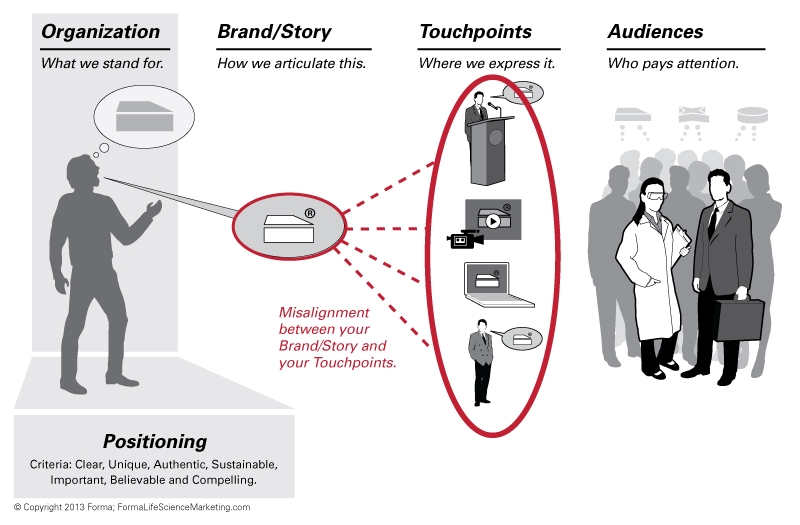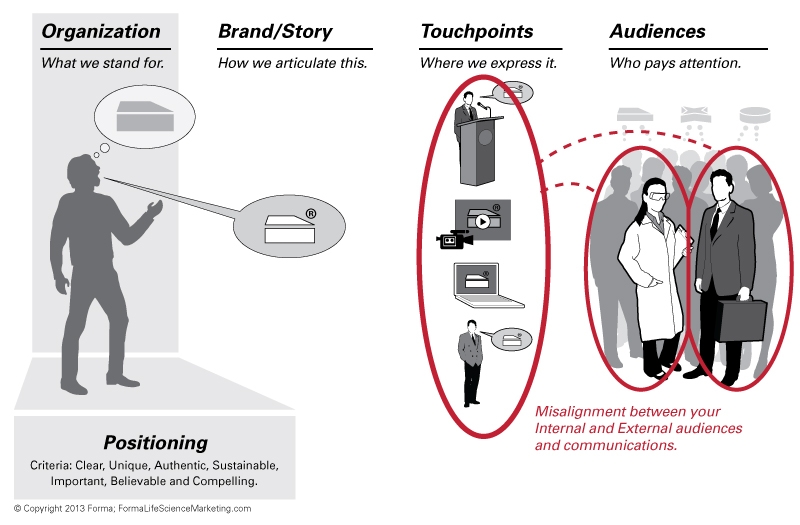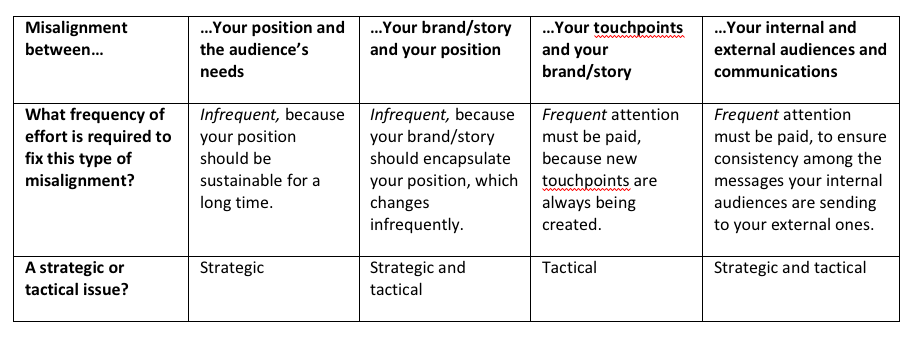Life Science Marketing Alignment – Part III: Diagnosing and Treating Misalignment
By David Chapin

SUMMARY
VOLUME 5
, NUMER 2
We continue our discussion of life science marketing alignment and misalignment by discussing the most common, and potentially most damaging, types of life science marketing misalignment. We provide a guide to diagnosis these conditions and some thoughts about treating these common misalignments.
The four types of life science marketing misalignment.
In our last two issues we discussed the four potential types of misalignment in life science marketing. These four types of misalignment correspond to different stages in the marketing mechanism of action.
There can be misalignment between:
- Your position and your audiences’ needs
- Your brand/story and your position
- Your touchpoints and your brand/story or
- Your internal and external audiences and communications
Life science marketing alignment between your brand/story and your touchpoints.
If each and every touchpoint is not aligned with your brand/story, your organization will not be expressing itself consistently. The message on your web site won’t be consistent with the messages from your trade show presence, your email blasts, your white papers or your sales presentations. That is, the “story” the audience hears from you will vary widely, depending on which touchpoints they come in contact with or which employee they happen to be talking to.

Figure 1: Alignment between your Touchpoints and your Brand/Story. Lack of consistency of expression across all touchpoints is the most common misalignment in life science marketing.
Nothing could be more damaging to an organization’s communication efforts. If half your touchpoints communicate (to pick a random example) “We’re the fast ones,” and the remaining touchpoints communicate “We’re the precise ones,” then the mixed messages will confuse your audiences. Unfortunately, your audiences are too busy and bombarded by too many other messages, so they won’t do your work for you and sort out the correct message. They may combine the two messages, or they’ll pick one or the other, or they’ll make one up, or they’ll just ignore what you say altogether, because you can’t keep your story straight.
With mixed messages, you are wasting the most precious part of your life science marketing arsenal: the audiences’ attention. Rather than every message reinforcing every other message – which is what happens when all your messages are consistent – you end up wasting the opportunity to reinforce your position in the audiences’ minds.
This concept – that inconsistency in messaging is confusing to the audience and causes them to tune out, rather than work harder to understand the message – can be hard for some scientists to grasp. After all, science is full of details, and scientists are used to working with multiple ideas at once. But buyers, even scientifically-trained buyers, need clarity, and consistency is a necessary precursor to clarity.
Misalignment between your touchpoints and your brand/story is particularly common:
- for organizations with a weak marketing department (where the tactical needs of an immediate marketing crisis are allowed to outweigh the strategic requirements to keep your expressions consistent),
- for organizations without a “brand police” – a department or person with the responsibility and authority to maintain brand/story discipline and consistency,
- for organizations that don’t have a clear internal communications plan (so internal audiences create their own story that they then communicate to the outside world), and
- for older organizations (for whom it might have been a while since there was a deliberate alignment of the position, the brand/story and the touchpoints).
Diagnosing poor life science marketing alignment between your brand/story and your touchpoints.
This type of misalignment is the most common of the four. Fortunately, it is relatively easy to diagnose:
- Do you have a guiding document for your brand/story (e.g., your messages, your tagline, your visual expressions or your corporate identity) and a person responsible for ensuring that these are coordinated at each customer touchpoint?
- Do all your touchpoints (e.g., your website, your trade show efforts, your whitepapers, your webinars, your email blasts) consistently express the same brand/story?
- Conduct an audit of your brand/story. While these types of brand audits can be complex, even a simple one can reveal surprising results. To conduct a simple audit, gather examples of every touchpoint, across the entire Ladder of Lead Generation. Print copies of everything with your corporate identity on it: for example, the home page of your web site, pictures of your trade show booth, the title pages of your white papers, your email blasts, your business cards, advertisements, etc. Look carefully for inconsistency in the use of messages, your tagline, colors, images, etc. If you find some types of inconsistency, you can be sure that much more inconsistency exists in the minds of the audience than is obvious to you.
- Ask your salespeople (individually) to write down a single sentence that describes your key message. Or ask them to write down their 30-second elevator pitch. Compare the results from different individuals. If you find inconsistencies, then your audience is hearing inconsistencies, and you suffer from this type of misalignment.
- Conduct perception research with your audiences. This will give you a good sense of how much of your message is getting through to your audiences. Ask them what they know of your organization and what touchpoints they are aware of. Probe to determine your offering’s unique value. If you find significant inconsistencies here, then you’re likely suffering from this type of misalignment.
It is unlikely that you’ll conduct this perception research with your audiences all by itself. But there are many opportunities to gather information from your audiences, such as trade shows, sales visits, and online surveys. It is possible to “piggyback” onto these opportunities and gather information from your audiences.
Treating life science marketing misalignment between your touchpoints and your brand/story.
As we’ve said, this type of misalignment is the most common. It is potentially very damaging. To fix this, you’ll need to change your touchpoints to align with your brand/story. Fortunately, since new touchpoints are being created with some regularity, this opportunity should arise frequently.
Since consistency is so important for the long-term alignment of touchpoints with your brand/story, a written set of guidelines or a guiding document for your brand/story should be the first tool you turn to when fixing this problem.
Life science marketing alignment between your internal and external audiences and communications.
If the messages your internal audiences hear do not align with the messages your external audiences hear, then you will have misalignment between the two. In the past this was not a significant problem, because the two rarely communicated;

Figure 2: Alignment between your internal and external audiences and communications. With the democratization of marketing activities across all your entire organization, your internal audiences will drive more of your communications to your external audiences than ever before. Ensuring alignment between the two will become increasingly important.
This is the most insidious problem of the four we’re discussing, because it typically creeps in quietly as companies grow. In the life sciences, large service organizations tend to exhibit this type of misalignment, but frankly, this misalignment comes from lack of clarity and consistency, and so can appear at any stage of an organization’s growth. Internal alignment issues are rampant in life science organizations today. The rise of the multitude of new channels of communication, the democratization of communication (all employees are ambassadors for the organization, not just the marketing department), and the extreme demands put on employees and managers who now have to do “more with less” all combine to ensure that communicating a clear message to employees is difficult. So at the risk of making a broad generalization, it is likely that most life science organizations with more than a single layer of management have some form of this problem.
One classic example: If an ad campaign or your web site touts “service” but your internal audiences (like your CSRs) hear the message “profit per customer” then your customer service reps won’t be focused on service, they’ll be focused on profit per customer. Rather than providing the best service possible, they’ll focus on maximizing the profit from each interaction. What message will that send to your customers? A confused message, at best.
Diagnosing poor life science marketing alignment between your internal and external audiences and communications.
To diagnose this situation, here are a few questions you can ask:
- Does you leadership communicate the same brand values to both internal and external audiences?
- Do you have a training program in place to help all employees learn how to communicate to people outside the organization? If you don’t, the potential for this type of communication misalignment is greater.
- Do your employees know who their top three competitors are, and how you are different/better than each? Are their answers consistent from employee to employee?
- Follow the buying cycle from the point of view of a prospect. That is, become an “undercover boss.” What you hear may surprise you.
- Do you have an integrated communications plan that addresses both internal and external audiences using similar or identical messages?
- Conduct an internal alignment survey, probing employees impressions and determining how consistent and aligned they are with the messages being provided to external audiences. This research has a different focus from research that HR departments typically undertake. As in all research, the questions you ask and the way you ask them will determine with value of the discoveries you make.
Treating life science marketing misalignment between your internal and external audiences and communications.
To address this misalignment, you’ll need to change your communications, either externally, internally or both. Typically, your internal communications will change to align with your external communications, though on occasion external communications must change. This type of fix is typically an ongoing effort, as new touchpoints are being constantly created.
Different life science marketing challenges require different treatments.
The different types of misalignments require different types of effort, as the following table shows:
These components can be organized in a hierarchy: your audiences’ needs trump your position (you must align your position with your audience needs), your position trumps your brand/story (you must align your brand/story with your position), your brand/story trumps your touchpoints (you must align your touchpoints with your brand/story) and your external audiences trump your internal audiences (you must align your internal communications with your external ones).
Conclusion
The Marketing Mechanism of Action provides a model for how marketing works. It can also be used to illuminate the causes of many types of ineffective marketing. There are four main types of poor alignment along the Marketing Mechanism of Action. There can be misalignment between:
- Your position and your audiences’ needs
- Your brand/story and your position
- Your touchpoints and your brand/story or
- Your internal and external audiences and communications.
Each of the different types of misalignment can impede your marketing effectiveness. Since the treatment is different for each, proper diagnosis is important. Misalignment in life science marketing can be very damaging. It can lead to poor marketing performance, missed opportunities, confused messages and confused audiences.
The Marketing of Science is published by Forma Life Science Marketing approximately ten times per year. To subscribe to this free publication, email us at info@formalifesciencemarketing.com.
David Chapin is author of the book “The Marketing of Science: Making the Complex Compelling,” available now from Rockbench Press and on Amazon. He was named Best Consultant in the inaugural 2013 BDO Triangle Life Science Awards. David serves on the board of NCBio.
David has a Bachelor’s degree in Physics from Swarthmore College and a Master’s degree in Design from NC State University. He is the named inventor on more than forty patents in the US and abroad. His work has been recognized by AIGA, and featured in publications such as the Harvard Business Review, ID magazine, Print magazine, Design News magazine and Medical Marketing and Media. David has authored articles published by Life Science Leader, Impact, and PharmaExec magazines and MedAd News. He has taught at the Kenan-Flagler Business School at UNC-Chapel Hill and at the College of Design at NC State University. He has lectured and presented to numerous groups about various topics in marketing.
Forma Life Science Marketing is a leading marketing firm for life science, companies. Forma works with life science organizations to increase marketing effectiveness and drive revenue, differentiate organizations, focus their messages and align their employee teams. Forma distills and communicates complex messages into compelling communications; we make the complex compelling.
© 2024 Forma Life Science Marketing, Inc. All rights reserved. No part of this document may be reproduced or transmitted without obtaining written permission from Forma Life Science Marketing.

